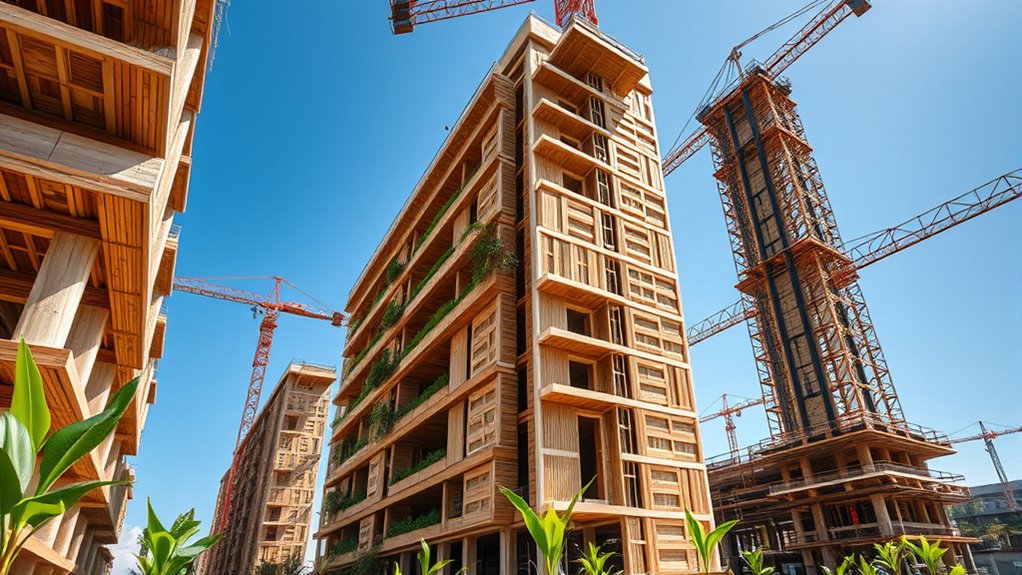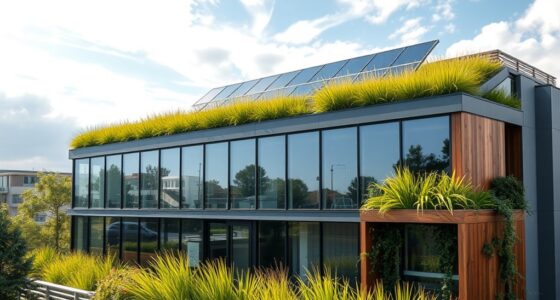Circular-economy materials are revolutionizing the way you approach construction by promoting reuse, waste reduction, and design for disassembly. These practices allow you to repurpose existing components, incorporate recycled materials, and plan projects that can be easily dismantled and reused later. This shift makes buildings more sustainable, cost-effective, and resource-efficient. As you explore further, you’ll discover how industry collaboration and innovative strategies are shaping a more resilient construction future.
Key Takeaways
- Circular-economy materials promote sustainability by reducing waste and enabling reuse, transforming traditional building practices.
- Designing for disassembly and modularity facilitates material reuse and adapts to future needs.
- Incorporating recycled and salvaged materials lowers environmental impact and conserves raw resources.
- Industry collaboration enhances supply chain transparency and promotes innovative reuse strategies.
- These practices lead to cost savings, improved certifications, and a more resilient, resource-efficient construction sector.

The construction industry is increasingly embracing circular economy materials to reduce waste and boost sustainability. This shift isn’t just a trend; it’s a necessary step toward creating more responsible and efficient building practices. By adopting reuse strategies, you can substantially minimize the amount of waste sent to landfills, making your projects more eco-friendly and cost-effective. Reuse strategies involve repurposing existing materials, salvaging components from old structures, and designing buildings with future disassembly in mind. Instead of demolishing and discarding, you can carefully dismantle parts of a structure to reuse them elsewhere, reducing demand for new raw materials and cutting down on waste generation. This approach not only conserves resources but also fosters innovation, as you seek out creative ways to give old materials a second life.
Adopting reuse strategies reduces waste, conserves resources, and fosters innovation in sustainable construction.
Waste reduction becomes a central goal when integrating circular economy principles into construction. You’ll find that planning ahead and implementing thoughtful material management can drastically decrease the amount of waste produced during construction and renovation. For example, modular building designs allow for easier adjustments and disassembly, promoting reuse and reducing leftovers. When you prioritize waste reduction, you’re not only decreasing environmental impact but also cutting costs—less debris means fewer disposal fees and less need for virgin materials. You can also incorporate recycled materials like crushed concrete, recycled steel, or reclaimed wood, turning what would be waste into valuable resources. These practices align with circular economy goals by keeping materials within the supply loop and preventing them from becoming waste prematurely. Utilizing supergrain materials and other innovative resources can further enhance the sustainability of your projects.
Moreover, adopting circular economy materials encourages collaboration across the supply chain. Suppliers and contractors work together to source sustainable materials, share knowledge about reuse strategies, and develop innovative solutions for waste management. This collective effort enhances project efficiency and promotes transparency, paving the way for more sustainable construction practices. You’ll notice that as more firms embrace these concepts, the industry begins to shift toward a more resilient and resource-efficient model. This transformation not only benefits the environment but also improves your project’s overall sustainability profile, potentially leading to certifications like LEED or BREEAM.
In essence, the integration of circular economy materials in construction empowers you to rethink traditional building methods. By actively pursuing reuse strategies and prioritizing waste reduction, you contribute to a more sustainable future. You’ll see that these practices foster smarter resource management, reduce environmental impact, and create a built environment that is both innovative and resilient. As the industry continues to evolve, circular economy principles will become indispensable, guiding you toward more responsible and sustainable construction practices.
Frequently Asked Questions
How Do Circular Economy Materials Compare in Cost to Traditional Construction Materials?
You might wonder if circular economy materials cost more than traditional ones. Generally, they can be comparable or even cheaper, especially when considering material durability and long-term savings. Although supply chain complexity can increase initial costs, these materials often last longer and reduce waste. Over time, their sustainability benefits and durability can offset higher upfront expenses, making them a smart, cost-effective choice for construction projects.
What Are the Long-Term Environmental Impacts of Using Circular Materials?
Think of using circular materials like planting a tree that grows stronger each year. You’re boosting ecosystem resilience and promoting resource renewal, which benefits future generations. Long-term, these materials reduce waste and lessen environmental harm, helping ecosystems stay balanced and resilient. By choosing circular options, you’re investing in a sustainable future, ensuring natural resources regenerate instead of depleting, and creating a healthier planet for everyone.
How Do Building Codes Influence the Adoption of Circular Economy Materials?
Building codes substantially influence your adoption of circular economy materials by shaping industry standards. Policy barriers within these codes can slow innovation, while regulatory incentives encourage sustainable choices. When codes are flexible and promote reuse, recycling, and resource efficiency, you find it easier to implement circular materials. Conversely, rigid regulations may hinder progress, so advocating for updated standards helps you embrace sustainable construction practices more effectively.
Are Circular Materials Suitable for All Types of Construction Projects?
You might wonder if circular materials suit all construction projects. While they offer benefits like material durability and design flexibility, their suitability depends on specific project needs. For instance, some projects require high durability, making certain recycled materials ideal, while others benefit from flexible designs, which circular materials can support. However, factors like structural requirements and local regulations influence their application, so they’re not universally perfect but adaptable for many projects.
What Are the Challenges in Sourcing and Supplying Circular Economy Construction Materials?
You face challenges sourcing circular economy construction materials due to supply chain complexities and material standardization issues. Limited suppliers and fragmented logistics make it tough to guarantee consistent availability. Additionally, lack of standardized specifications hampers quality control and interoperability. These hurdles can slow adoption, but as industry standards evolve and supply networks strengthen, sourcing circular materials will become more streamlined, supporting sustainable construction practices worldwide.
Conclusion
Think of the construction industry as a mighty river, once flowing wastefully, now guided by the circular economy’s gentle hands. As you embrace these innovative materials, you’re like a skilled navigator steering toward a cleaner, sustainable future. Every recycled brick and repurposed wood becomes a ripple of change, transforming the landscape into a vibrant, endless stream of renewal. By choosing circular materials, you’re not just building structures—you’re shaping a resilient, thriving world.










